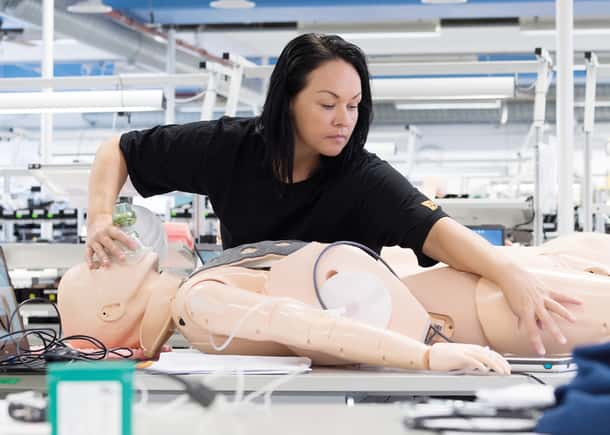Products & Solutions
Minimizing our environmental impact with an ambition to create low-carbon and circular solutions with optimized impact potential.
Sustainability

Minimizing our environmental impact with an ambition to create low-carbon and circular solutions with optimized impact potential.

Products and components represent the biggest part of our total company emissions and will require great transition from how we design and produce our products, to how we deliver our solutions. We aim to create low-carbon and circular solutions with optimized impact potential. Below you will find highlights from our action plan toward our ambition.

In 2019, carbon emissions embedded in our products totaled 33 kt, close to 50 % of our total emissions. In 2021, these had increased to 44 kt because of increased output but reduced in 2022 to 38 kt as our reduction initiatives started to come into effect. The emissions relative to sales revenue were 3 % lower in 2022 compared with 2019.
We have implemented different technologies, processes, and products to reduce carbon emissions. Some of these have just recently been launched, while others are planned for future release. Once these are in place, the total emissions will see a significant reduction.
Reduce, reuse, recycle
Our product design philosophy follows the ‘reduce, reuse, recycle’ mindset. We optimize resources by using smarter design techniques to minimize material use. We prioritize durability, reusability, and refurbishment where feasible. And at the end of a product’s life cycle, we design for recyclability.
Products and materials used in our products represent the biggest part of our total emission, so focus on sustainability in our product development process is key. We have developed and are implementing three key tools to ensure that we make informed decisions in the product development process: the ZeroAim Tool and Knowledge Library, the Simplified LCA Tool and a Sustainability Business Case Model.
Carbon footprints reduction
We use post-consumer/industrial recycled content and highly recyclable plastics to reduce carbon footprint and improve recyclability. We replace fossil-based polymers with low-carbon renewable feedstock for identical product functionality. In textiles/packaging, we enable high recycled content for mom-material packaging to enhance recyclability.
Circularity
In addition to designing for recyclability and refurbishment, we are also looking into how we can enhance recycling and refurbishment internally. As discussed in the Net Zero Site section, we have good systems and initiatives in place to recycle scrap, and waste, and in Mexico we have expanded to also take-back and recycle used products.
Digitization and digitalization
To create sustainable solutions, improving digitization and digitalization is crucial. Digitization involves creating software solutions to reduce material usage while digitization converts physical products into digital form for tracking and enhancing functionality.
Services
We minimize environmental impact while increasing product use. “Needs-based subscription models” and a sharing-based ownership model improve resource efficiency and reduce waste. This allows us to save lives with the same or lower carbon footprint.
The pandemic led to a shift towards virtual services, which offers improved value due to time, emission, and cost efficiencies. Virtual services expand productivity, efficiency, utilization, and patient risk-reduction through better learning and up-time. We have a goal to offer 80% of services virtually.

SimMan, the world’s most widely used patient simulator is now packed in cardboard rather than the textile suitcases it has traditionally been packed in.
This initiative has led to a significant reduction in carbon emissions from 134.92 kg CO2e for one set of suitcases to 9.167 kg CO2e. In addition, the entire packaging is fully recyclable, and being half the size of the old packaging has led to space efficiency in shipping.

Little Anne, our highest volume basic life support manikin, has been redesigned resulting in a 68% reduction in carbon emissions per manikin. The product uses 59% less material than the previous version and 60% recycled plastics. Single-use PVC lungs are replaced by a single-use filter, and the stackable design uses less volume in transportation.

A new Laerdal AED Trainer, will be launched in 2023. As a generic AED trainer, it allows customers to buy one training model instead of multiple versions. This, together with the use of recycled material, has resulted in a estimated carbon reduction of us to 70% compared with the previous model.
The ZeroAim Tool is a qualitative tool consisting of sustainability-related questions and tips on making the solution more sustainable.
The tool is divided into three different categories;
Within each category are questions designed for the respective use model of the product, with a tip for each question.
To complement the tool, we have a Sustainability Knowledge Library consisting of insight and guidelines for designing more sustainable solutions. The tool is being implemented by the teams throughout the product development process.
The Simplified LCA Tool is a quantitative tool with a calculator to measure CO2e emissions from products and logistics.
We are implementing the tool to be used to compare one material type to another in the product development process and conduct a complete LCA for a product.
By combining the ZeroAim Tool and the Simplified LCA Tool, we ensure that the teams get guidelines on how to design for more sustainable solutions and use the LCA tool to check and ensure that the design choices lead to minimized product emissions.
The Sustainability Business Case Model is a tool used to ensure sustainability is integrated into the commercial Business Case Model. The Sustainability Business Case Model uses input from the Simplified LCA Tool and illustrates the CO2e emission against the monetary cost.
We are working on implementing an internal shadow price for carbon in the Business Case Model.